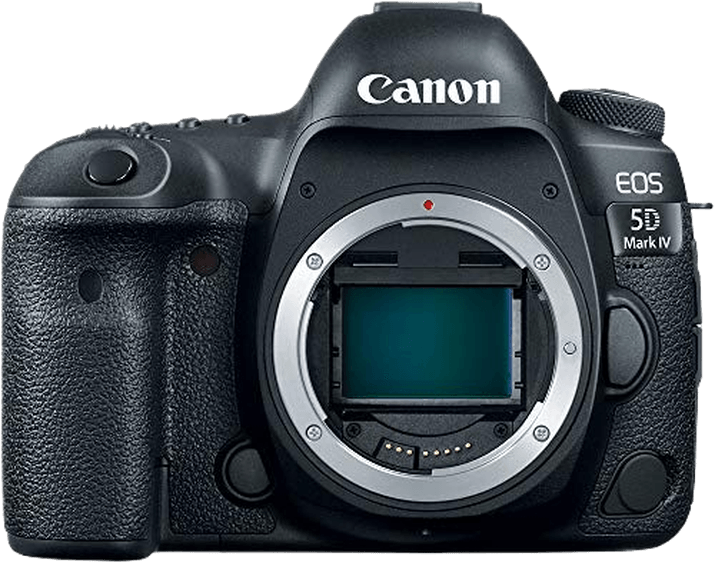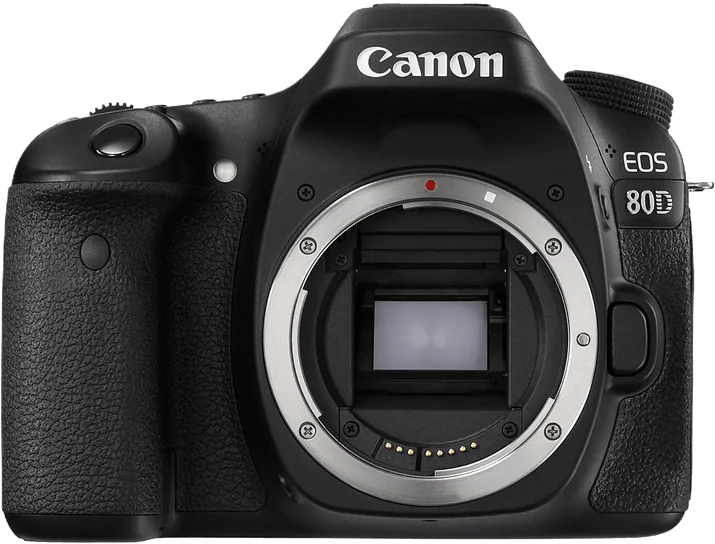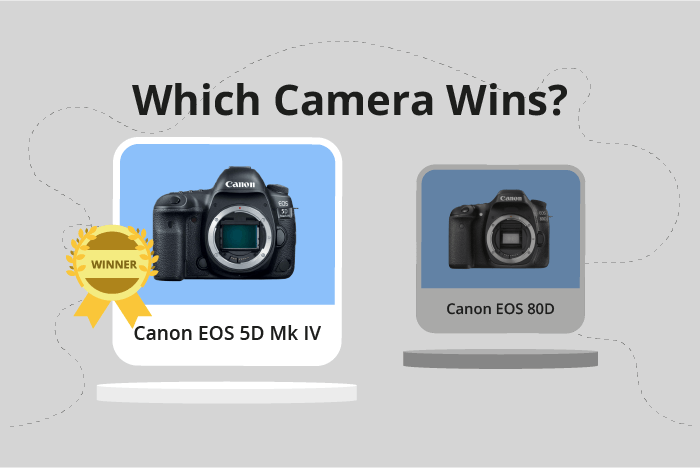Canon EOS 5D Mark IV vs EOS 80D Comparison
Canon EOS 5D Mark IV

Canon EOS 80D

The Canon EOS 5D Mark IV outperforms the Canon EOS 80D with a score of 75/100 compared to 64/100. Both cameras are DSLRs released in 2016, with the 5D Mark IV announced on August 25th and the 80D on February 18th. They share similarities in size and weight, with the 5D Mark IV measuring 151 x 116 x 76mm and weighing 890g, while the 80D has dimensions of 139 x 105 x 79mm and weighs 730g.
The 5D Mark IV’s higher score reflects its better performance, which can be attributed to its superior specifications. However, the 80D has a lower launch price of $1200 compared to the 5D Mark IV’s $3500, making it a more budget-friendly option.
Considering the differences in performance and price, the 5D Mark IV is a better choice for professional photographers seeking top-quality results, while the 80D is a more affordable option for hobbyists and enthusiasts.
Canon EOS 5D Mark IV vs EOS 80D Overview and Optics
The Canon EOS 5D Mark IV outperforms the Canon EOS 80D in optics, earning a score of 76/100 compared to the 80D’s 63/100. Both cameras share several specifications, such as their shooting speed of 7 frames per second, CMOS sensor type, and lack of image stabilization. However, the 5D Mark IV proves to be superior in certain aspects.
The 5D Mark IV boasts a higher megapixel count of 30.4, compared to the 80D’s 24.2 megapixels, resulting in more detailed images. The 5D Mark IV also has a superior sensor with a DXOMARK score of 91 and a full-frame size, while the 80D’s sensor scores 79 and is APS-C sized. This difference in sensor size and quality contributes to the 5D Mark IV’s ability to capture better low-light and high-resolution images. Additionally, the 5D Mark IV utilizes a more advanced Digic 6+ processor, which further enhances the camera’s performance and image quality.
On the other hand, the 80D has a few advantages over the 5D Mark IV. Its APS-C sensor provides a greater depth of field, which can be beneficial for specific shooting situations. Additionally, the 80D uses an EF-S lens mount, which accommodates a wider variety of lenses, offering more versatility to photographers.
Taking these points into consideration, the Canon EOS 5D Mark IV is the clear winner in terms of optics, providing superior image quality and sensor performance. However, the Canon EOS 80D offers greater versatility with its lens mount and depth of field, making it a suitable choice for certain scenarios.
Canon EOS 5D Mark IV vs EOS 80D Video Performance
The Canon EOS 5D Mark IV outperforms the Canon EOS 80D in video capabilities with a score of 91/100, a significant 21-point difference from the 80D’s score of 70/100. Both cameras share common features such as built-in time-lapse functionality, but the 5D Mark IV excels in other aspects.
The 5D Mark IV boasts a maximum video resolution of 4K (4096 x 2160), providing sharper, more detailed footage than the 80D, which only offers Full HD (1920 x 1080) resolution. Additionally, the 5D Mark IV has a maximum video frame rate of 120fps, allowing for smoother slow-motion footage compared to the 80D’s 60fps limit. These features make the 5D Mark IV a superior choice for videographers seeking high-quality video performance.
On the other hand, the Canon EOS 80D does not surpass the 5D Mark IV in any specific video capabilities. However, it may still be a suitable option for users who prioritize other features, such as budget or photography capabilities, over video performance. The 80D’s Full HD resolution and 60fps frame rate are still sufficient for casual video recording or users who do not require the highest video quality.
In comparing the video capabilities of the Canon EOS 5D Mark IV and the Canon EOS 80D, the 5D Mark IV clearly stands out as the better choice for those prioritizing video performance. Its 4K resolution and 120fps frame rate offer a significant advantage over the 80D’s Full HD resolution and 60fps limit. While the 80D may be suitable for casual video users, the 5D Mark IV is the clear winner for videographers seeking the highest quality and performance.
Canon EOS 5D Mark IV vs EOS 80D Features and Benefits
The Canon EOS 5D Mark IV emerges as the winner in the comparison of features, scoring 74 out of 100, while the Canon EOS 80D scores 70 out of 100. Both cameras share some common specifications, such as touchscreen capabilities, WIFI connectivity, and the absence of Bluetooth.
The 5D Mark IV outperforms the 80D in several aspects. Firstly, it boasts a larger screen size of 3.2 inches compared to the 80D’s 3 inches. Additionally, the 5D Mark IV has a higher screen resolution, with 1,620,000 dots versus the 80D’s 1,040,000 dots. This difference results in a sharper and clearer display for the 5D Mark IV. Another advantage of the 5D Mark IV is its GPS functionality, which the 80D lacks. This feature allows for geotagging of images, making organization and location tracking more convenient.
On the other hand, the Canon EOS 80D holds an advantage in one area: its flip screen. The presence of a flip screen allows for more flexibility in composing shots, especially in challenging angles or positions. This feature is absent in the 5D Mark IV.
In comparing the features of the Canon EOS 5D Mark IV and Canon EOS 80D, the 5D Mark IV is the superior camera due to its larger screen size, higher screen resolution, and GPS capabilities. However, the 80D does offer the benefit of a flip screen, which may be of interest to some users. Ultimately, the choice between the two cameras will depend on the specific needs and preferences of the photographer.
Canon EOS 5D Mark IV vs EOS 80D Storage and Battery
The Canon EOS 5D Mark IV outperforms the Canon EOS 80D in storage and battery with a score of 71/100 to 43/100. Both cameras share similarities, accepting SD, SDHC, and SDXC (UHS-I compatible) memory cards and utilizing the LP-E6N battery type. Neither camera offers USB charging.
The 5D Mark IV has an advantage with two memory card slots, allowing for more storage and flexibility. This feature is useful for professionals who need to manage large amounts of data or backup their files. On the other hand, the 80D has a slightly longer battery life of 960 shots compared to the 900 shots of the 5D Mark IV, which could be beneficial for extended shooting sessions.
Considering these factors, the Canon EOS 5D Mark IV’s superior storage capabilities make it a better choice for professionals, while the Canon EOS 80D’s marginally longer battery life may be more appealing to casual users.
Canon EOS 5D Mark IV vs EOS 80D – Our Verdict
Are you still undecided about which camera is right for you? Have a look at these popular comparisons that feature the Canon EOS 5D Mark IV or the Canon EOS 80D:

